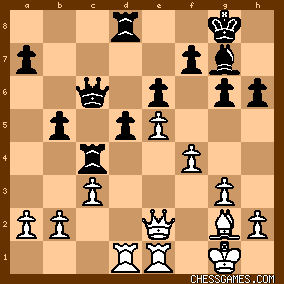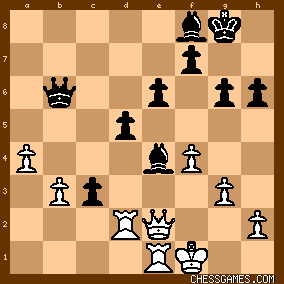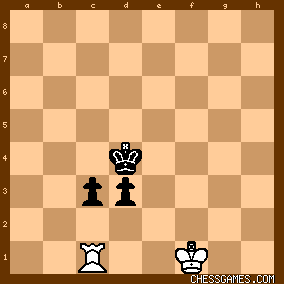|
< Earlier Kibitzing · PAGE 2 OF 2 ·
Later Kibitzing> |
| May-10-05 | | aw1988: Um, I know that. I'm wondering what I was thinking with my previous post... |
|
| May-10-05 | | suenteus po 147: <aw1988> Not that this will help you, but I often do the double blink when I am puzzled :) |
|
| May-10-05 | | aw1988: Um, yeah, but I think it was obvious at the time. |
|
| Aug-17-05 | | ARTIN: It's amazing how interesting the position right before 35...Rc3! is. Superficially White is Ok, he has a passed pawn, beautiful looking knight, there is an open file which he can try to grab. I guess the greatness of Petrosian is that he completely understands that all this so called pluses are absolutely useless because White's position has no prospects as his kingside weaknesses are too serious. |
|
| Aug-18-05 | | tacticalmonster: No offense, Benjamin, but I have to disagree with you saying that <the bishop pair is essentially a diagonal rook pair > Both rook can easily travel to the h8 dark square. A dark sauare bishop can of course do it with ease, but the other bishop can't. Conclusion: bishop pair can only complement each other while the rook pair can complement as well as reinforce. That makes bishop pair " half rook pair" ! |
|
Aug-18-05
 | | offramp: It seems as if every game I play through of Petrosian's has an exchange sacrifice in it. He did not have absolute values for the pieces, he seemed to have like a Huskisson's Sliding Scale of values. |
|
Aug-18-05
 | | offramp: Actually 18...Nc6 looks like the first exchange sacrifice; if white had played 19.Nb3 then the rook looks trapped. |
|
| Aug-18-05 | | paul dorion: <offramp> Interesting find. Troianescu did probably not like the complications
after:
19...b5
20 Qa3 b4
21 Qa4 Rh5
Then if
22 Bf3 bxc3
and black has the exchange for a pawn
and the white square bishop wich looks good.
or:
22 e5 dxe5!
23 Bxc6 exf4
24 Bxb7 Qxb7
26 Qxf4 bxc3
with a wild position where black has two pawns for the piece. |
|
Aug-20-05
 | | offramp: Troianescu in his prime would easily have beaten Velimirovic at his worst. |
|
| Sep-12-05 | | ARTIN: you make an interesting point, offramp. The scale of absolute values for pieces (i.e. knights and bishops are 3 pawns, rook is 5 etc) arose from so called "typical" positions. But not all positions are "typical" |
|
| Oct-05-05 | | Jgamazo: This is a great example of judging piece and postional values over material conciderations. The bishops are better than the rooks because they found better squares to dominate and attack from e4 and c5. But the key was the lack of safety for the white king after 25. ... Rxe4! This exchange sacrifice weakened the light squares around the white king and put the bishop on an optimal square dominating all the white pieces. Then black does it again 35. ... Rc3! eliminates white's only active piece; the knight. Caps the only open file for the white rooks to use, and white's space seems to be shrinking. Are there any other examples of double exchange sacrifices that were timed so well and were so devasting? Forget about the white passed pawn. Intimidating the black c pawn was a weak threat too. Whites' only hope is to open a hole on the kingside with his pawns, but the black monarch is too remote. 39. ...Bxc2 A precious bishop is exchanged for a lowly rook. Isn't this were all the commentators say
"the rest is a simple matter of technique."
Why doesn't the rook take the c pawn: 44.Rxc3? Qa1+ 45.Qe1+ 46.Kxe1 Bb4 47.Kd2 d4 wins the rook. And again on 49.Rxc3? Bb4 pins the rook 50.Kd2 d4 again wins the rook. |
|
| Sep-02-06 | | notyetagm: Petrosian clearly has a deeper understanding of chess than his opponent in this game. Petrosian games teach you the value of passed pawns and what an exchange is really worth. |
|
| Dec-23-07 | | isemeria: This is a beautiful game and a fine example of Petrosian's mastery. His understanding of the game was on a level us mortals can only dream of. |
|
| Jun-17-08 | | arsen387: 2 exchange sacs and the game is done! One can see very often in Petrosian's games the idea of sac'ing an exchange to obtain pass pawns. And the greatness of Iron Tiger was that almost always that worked for him. He really had amazingly deep understanding of the game. |
|
| Aug-14-09 | | xombie: Marvelous vision. Among other things, Bf8 was a great move. It sets up the exchange sac and the pawn advance following it. Other instructive points: the exchanging of pieces by white earlier on in the game seems dubious. Bxe7? gives up the DSB for the knight (which may have been caused by fears of the knight settling on c6, assisting its colleague) allows the queen to align with the bishop on the second rank, with long term dark square weaknesses. f4 must surely count as a mistake. It appears that white sets up a great center, but it only allows black to get a freer game. The refutation is unusual here, the exchange sacrifice. But we must note how the bishop and queen gang up on the long diagonal after that. |
|
| Jan-15-10 | | lentil: My 2-bits' worth on the B/R comparison (in 'normal' positions and here). Consider an open board: a rook can reach all squares, but a bishop can only reach half of them. By simple arithmetic, one can conclude that the rook is worth approximately two bishops (2:1 is pretty close to the standard evaluation of 5:3; the difference may be that diagonals come open more often than ranks/files. Of course, a knight can also reach all squares, but it takes longer to do this than a rook -- so velocity is another factor, which I will not consider here). Now I extend this 'square-counting' strategy to this game. After white's move 37, white's rooks can reach about 10 squares between them, but black's bishops can reach about 22. After black's move 38, white's rooks are almost totally immobile. (and black has numerous threats against white's open king side.) The moral: activity is more important than mass. (Moving objects are more dangerous than static ones.) |
|
| Aug-30-10 | | goldenbear: Is 23.Nb4 good for White? I must be missing something... |
|
| Aug-30-10 | | Shams: <goldenbear> Did you have something in mind like 23.Nb4 Rc4 24.Nxc6 Qxc6 25.e5 d5<?>
click for larger view |
|
| Aug-30-10 | | goldenbear: <Shams> Yes, exactly. But now that I see the position with my eyes instead of in my head, I see that it is strategically won for Black instead of White. Black will eventually liquidate his queenside pawns, blockade White's remaining queenside pawn, and be left with an irresistible passed d-pawn. It suprises me that Black had any way of giving up his light bishop (which seemed the cornerstone of his entire strategy) while retaining the advantage. |
|
| Aug-30-10 | | Shams: <goldenbear> I agree. And black's bishop will have a lot to say on the g1-a7 diagonal. |
|
| Aug-30-10 | | goldenbear: <Shams> I probably wouldn't have looked at 22.b5!. A really suprising move! |
|
Apr-06-16
 | | offramp: The position after 36....bxc3 shows something unusual about pieces and connected passed pawns.

click for larger viewA bishop might manage to stop the pawns,

click for larger view
...but a rook might be in real trouble:

click for larger view |
|
| Apr-06-16 | | morfishine: <30.a4> lost this game when the simple 30.axb4 draws at worst |
|
May-14-20
 | | cwcarlson: 36.♘c3? ∓; 36.a5 ♕a5 37.♘c3 bc 38.♖d4= Houdini |
|
Jul-04-20
 | | plang: 12 Nxd4?! was an odd decision leading to an open Sicilian pawn structure that does not seem to favor White. Was 18..Nc6?! a sacrifice or an oversight? - in any event White should have played 19 Nb3 as Black's compensation looks dubious. 28 h4 was suggested providing luft for the king; instead he mistakenly allowed the b4 break. Marin showed that h4 would not have solved White's problems: 30 h4!?..bxa 31 bxa..Rc8 32 Kh2..e5 33 fxe..Be5 Qe3..h5 when White's position would have been difficult. Declining the second exchange with 36 Nd4..Bc5 37 Red1..Bxd4 38 Rxd4..Bf3 would have won easily for Black. |
|
 |
|
< Earlier Kibitzing · PAGE 2 OF 2 ·
Later Kibitzing> |





